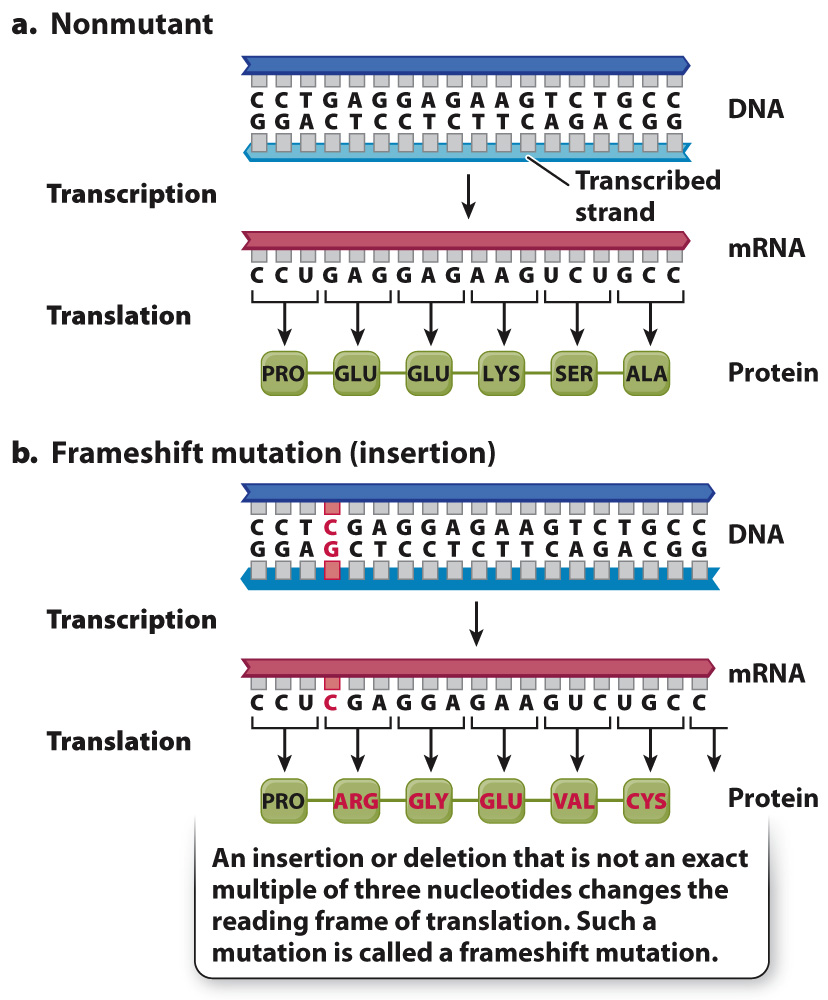Small insertions and deletions involve several nucleotides.
Another relatively common type of mutation is the deletion or insertion of a small number of nucleotides. In noncoding DNA, such mutations have little or no effect. In protein-
The effects of a deletion of three nucleotides can be seen in cystic fibrosis. This disease is characterized by the production of abnormal secretions in the lungs, liver, and pancreas and other glands. Its chief symptoms are recurrent respiratory infections, malnutrition resulting from incomplete digestion and absorption of fats and proteins, and liver disease. Patients with cystic fibrosis have an accumulation of thick, sticky mucus in their lungs, which often leads to respiratory complications, including recurrent bacterial infections. Untreated, 95% of affected children die before age 5. With proper medical care, including regular physical therapy to clear the lungs, antibiotics, pancreatic enzyme supplements, and good nutrition, the average life expectancy is currently 30 to 40 years.
The mutations responsible for cystic fibrosis are in the gene encoding the cystic fibrosis transmembrane conductance regulator (CFTR) (Fig. 14.9). The CFTR protein is a chloride channel, which acts as a transporter to pump chloride ions out of the cell. Malfunction of CFTR causes ion imbalances that result in abnormal secretions from the many cell types in which the CFTR gene is expressed. About 70% of the mutations associated with cystic fibrosis have a specific mutation known as Δ508 (delta 508), which is a deletion of three nucleotides that eliminates a phenylalanine normally present at position 508 in the protein. The missing amino acid results in a CFTR protein that does not fold properly and is degraded before reaching the membrane. Some researchers hope that future therapy will include drugs that stabilize the mutant protein or even treatments that repair the defective gene in affected cells.

Small deletions or insertions that are not exact multiples of 3 can cause major changes in amino acid sequence because they do not insert or delete entire codons. The effect of such a mutation can be appreciated by seeing how deletion of a single letter turns a perfectly sensible sentence of three-
THE BIG BOY SAW THE CAT EAT THE BUG
If the red E is deleted, the new reading frame for three-
THB IGB OYS AWT HEC ATE ATT HEB UG
The result is unintelligible. Similarly, an insertion of a single nucleotide causes a one-
Fig. 14.10 shows the consequences of a frameshift mutation in the β-globin gene. The normal sequence in Fig. 14.10a corresponds to amino acids 5–

Quick Check 2 The coding sequences of genes that specify proteins with the same function in related species sometimes differ from each other by an insertion or deletion of contiguous nucleotides. The number of nucleotides that are inserted or deleted is almost always an exact multiple of 3. Why is this expected?
Quick Check 2 Answer
The number of nucleotides that are inserted or deleted is almost always an exact multiple of 3 because each codon in the genetic code consists of three nucleotides. Any insertion or deletion that includes a number of nucleotides that is not an exact multiple of 3 shifts the reading frame, and the resulting sequencing will most likely code for a nonfunctional protein.